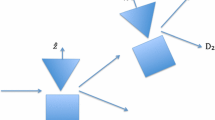Summary
Four definitions of the principle of local causes, each of which, when applied to a theory, leads to a different mathematical property of the theoretical predictions, are considered and physical justifications given. The predictions of quantum theory are shown to contradict three of those four concepts of locality. Conclusions are drawn about the physical process and about the interpretations of quantum theory or any other theory that would provide the same predictions. Several inter-pretations are still possible.
Riassunto
Si considerano quattro definizioni del principio di cause locali, ciascuna delle quali, quando applicata ad una teoria, porta a una diversa proprietà matematica delle predizioni teoriche, e si forniscono giustificazioni teoriche. Si mostra che le predizioni della teoria quantistica sono in contraddizione con tre di questi quattro concetti di località. Si traggono conclusioni riguardo i processi fisici e le interpretazioni della teoria quantistica o di qualsiasi altra teoria che fornisca le stesse predizioni. Sono ancora possibili molte interpretazioni.
Резюме
Рассматриваются четыре определения принципа локальных причин, каждое из которых приводит к различным математическим свойствам теоретических предсказаний. Показывается, что предсказания квантовой теории противоречат трем из этих четырех концепций локальности. Делаются выводы о физическом процессе и об интерпретации квантовой теории или любой другой теории, которая давала бы те же предсказания. Оказываются возможными другие интепретации.
Similar content being viewed by others
References
J. S. Bell:Physics,1, 195 (1964).
H. P. Stapp:Phys. Rev. D,3, 1303 (1971).
J. F. Clauser andM. A. Horne:Phys. Rev. D,10, 526 (1974).
J. S. Bell: Res Th 2053 CERN and communication at theVI Gift Conference, Jaca, June 2–7, 1975.
N. Herbert:Amer. Journ. Phys.,43, 315 (1975).
H. P. Stapp:Nuovo Cimento,40 B, 191 (1977).
P. H. Eberhard:Nuovo Cimento,38 B, 75 (1977).
P. A. Moldauer: submitted to be published (1977).
The Monte Carlo simulation is a technique to generate values of experimental results, statistically distributed like the theoretical probability distribution, using random numbers.
Property 3 would be satisfied if any one of the four domainsS(O, A, B) in fig. 2 were rotated by 90° about its center of gravity located between the two ellipses.
As in the time-dependent Boltzmann equations.
The description of the «process» or «mechanism» is meant to be an algorithm that could generate values of α and β according to the theoretical probability distribution. Of course, if the theory is not deterministic, the algorithm must use random numbers.
I owe toJ. S. Bell the idea that Monte Carlo simulation can easily demonstrate that determinism can be restored in quantum theory.J. S. Bell: private communication (July 1977). A different approach is taken byD. Bohm:Phys. Rev.,85, 166, 180 (1952).
For instance, in day-to-day life, if it is assumed that somebody’s decision would not depend on a particular set of circumstances, chosen by somebody else, it means that the first person’s decision would be the same whatever choice is made by the second one. However, there is no deterministic theory to predict the first person’s decision.
J. F. Clauser, M. A. Horne, A. Shimony andR. A. Holt Phys. Rev. Lett.,23, 80 (1969).
A. Einstein, B. Podolsky andW. Rosen:Phys. Rev.,47, 777 (1935).
I owe toH. P. Stapp the idea of presenting the remaining possible interpretations of quantum theory in this way.H. P. Stapp: private communication (1974).
A. Aspect:Phys. Rev. D,14, 1944 (1976).
S. J. Freedman andJ. F. Clauser:Phys. Rev. Lett.,28, 938 (1972).
E. S. Fry andR. C. Thompson:Phys. Rev. Lett.,37, 465 (1976).
A. R. Wilson, J. Lowe andD. K. Butt:J. Phys. G.,2, 613 (1976).
For a review of such experiments, seeJ. F. Clauser andA. Shimony: LLL preprint UCRL-80745, Lawrence Livermore Laboratory, Livermore, Calif., submitted toRep. Prog. Phys.
For instance,P. H. Eberhard: CERN 72-1 (1972), unpublished.
For instance,P. H. Eberhard, R. D. Tripp, Y. Déclais, J. Séguinot, P. Baillon, C. Bricman, M. Ferro-Luzzi, J. M. Perreau andT. Ypdilantis:Phys. Lett.,53 B, 121 (1974);W. C. Carithers, J. H. Christenson, P. H. Eberhard, D. R. Nygren, T. Modis, T. P. Pun, E. L. Schwartz andH. Sticker:Phys. Rev. D,14, 290 (1976).
H. P. Stapp: LBL 3837, Lawrence Berkeley Laboratory, Berkeley, Calif. (1975).
P. H. Eberhard: remark at theThinkshop on Physics, Experimental Quantum Mechanics, Erice, Sicily (1976); made in response to the paper presented byO. Costa de Beauregard.
E. P. Wigner:Symmetries and Reflections (Blomington, Ind., 1967).
For an extensive list of references, seeM. Jammer:The Philosophy of Quantum Mechanics (New York, N. Y., 1974).
O. Costa de Beauregard:Dialectica,19, 280 (1965).
J. Von Neumann:Mathematical Foundations of Quantum Mechanics (Princeton, N. J., 1955).
A. M. Gleason:Journ. Math. Mech.,6, 885 (1957).
J. S. Bell:Rev. Mod. Phys.,38, 447 (1966).
For a general review, seeF. J. Belinfante:A Survey of Hidden Variables Theories (New York, N. Y., 1973).
Author information
Authors and Affiliations
Additional information
To speed up publication, the author of this paper has agreed to not receive the proofs for correction.
Traduzione a cura della Redazione.
Переведено редакцией.
Rights and permissions
About this article
Cite this article
Eberhard, P.H. Bell’s theorem and the different concepts of locality. Nuov Cim B 46, 392–419 (1978). https://doi.org/10.1007/BF02728628
Received:
Published:
Issue Date:
DOI: https://doi.org/10.1007/BF02728628




